Cooking
How Food Preferences Change During Space Travel
Keen to discover how microgravity alters astronauts’ taste buds and meal choices? Explore the surprising shifts in food preferences during space travel.
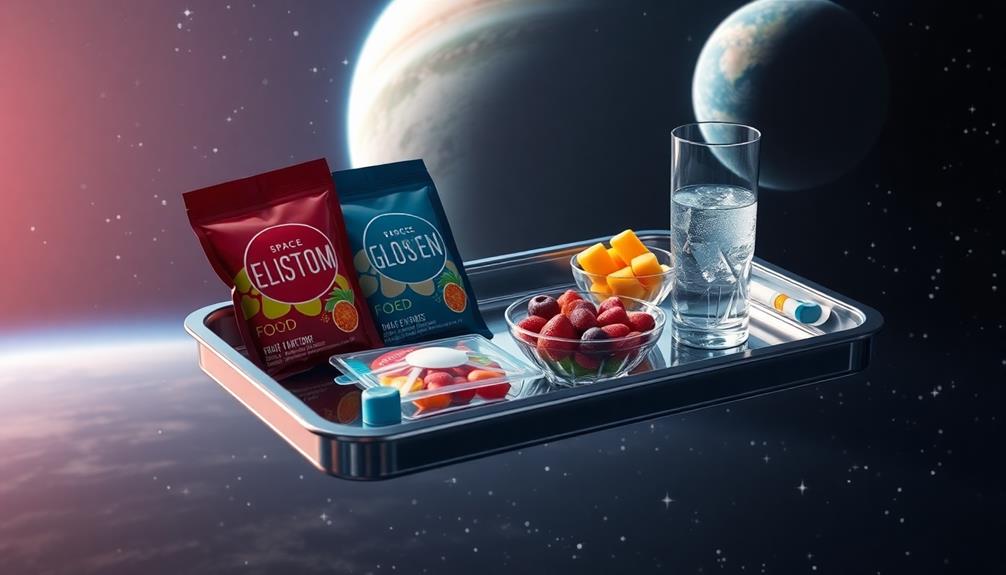
During space travel, your food preferences can change considerably due to altered taste perception and menu fatigue. You might find familiar foods tasting bland because microgravity affects your sense of taste and smell, making you crave bolder flavors instead. With limited meal options, the repetition can lead to a drop in meal enjoyment and nutritional intake. To combat this, astronauts often prefer stronger spices to enhance their dining experience and maintain morale. Innovations in space food technology aim to provide more personalized and enjoyable meals to meet these changing needs, revealing a fascinating aspect of life beyond Earth.
Key Takeaways
- Astronauts experience menu fatigue due to repetitive meal options, leading to decreased appetite and nutritional intake during long missions.
- Taste and smell senses change in microgravity, favoring bolder flavors and stronger spices to enhance meal satisfaction.
- Altered aroma perception affects flavor experience, making robustly flavored dishes more appealing to astronauts in space.
- Nutritional challenges arise from menu fatigue and lack of fresh produce, necessitating varied meal options to maintain health.
- Innovations like 3D food printing and personalized meal solutions aim to improve food variety and address astronauts' changing preferences.
Menu Fatigue in Space

Menu fatigue is a real challenge for astronauts on long-duration missions. When you're faced with the same food choices day after day, it's important to lose interest in your meals. NASA provides around 200 meal options, but even that can feel limited over time. This repetitiveness can lead to decreased food appeal and a potential loss of appetite, which is concerning for your nutritional needs.
Incorporating diverse and flavorful dishes, like those found in Brazilian cuisine, can help keep meals exciting and satisfying. Eating well in space is critical, as menu fatigue can greatly impact your intake of necessary nutrients. Research shows that when you're not excited about your meals, you might eat less, risking body mass loss and nutritional deficiencies.
To combat this, astronauts complete weekly surveys about food acceptability, considering factors like flavor, texture, and aroma. Implementing strategies like rotating menus and introducing diverse food choices can enhance your dining experience.
Sensory Changes During Flight

When you're in space, your taste and smell senses change dramatically.
This shift may lead astronauts to prefer dishes with stronger flavors and textures that can better satisfy their altered palates.
You might find yourself craving stronger flavors and noticing aromas more intensely, which can greatly alter your eating experience.
Understanding these sensory shifts is essential for creating enjoyable meals that satisfy your palate during long missions.
Altered Taste Perception
Many astronauts find that their taste perception shifts dramatically during space travel, leading to a preference for bolder flavors. This altered taste perception stems from changes in olfactory function and the sensitivity of taste buds, which can make familiar foods taste bland.
Notably, similar to how flavors are enhanced in traditional dishes like Muamba De Galinha, the robust spices and seasonings become essential for meal satisfaction in microgravity. In microgravity, body fluid shifts can affect nasal passages, intensifying the need for robust flavors. As a result, spices and seasonings become essential for meal satisfaction.
Research shows that sweet and salty tastes may be amplified in space, prompting astronauts to adjust their nutritional intake accordingly. You might notice that you crave stronger flavors, as trigeminal sensations like astringency and warmth are perceived more intensely in these conditions.
This means that your experience with food will be different, and you'll likely find certain aromas more appealing, as they contribute greatly to flavor perception.
Understanding these changes is important for meal planning in space. By recognizing how your taste perception alters, you can better accommodate your nutritional needs and enjoy your meals, making the journey through space a bit more palatable.
Enhanced Flavor Preferences
Astronauts often develop a marked preference for enhanced flavors during space travel, driven by significant sensory changes. In microgravity, your taste perception shifts, making you crave stronger flavors to compensate for decreased sensitivity in taste buds and altered olfactory function.
This phenomenon can be likened to the way certain dishes, such as Red-Braised Pork Belly, are celebrated for their rich and bold flavors, which would likely appeal to astronauts seeking robust tastes. This is why space food systems are adapting to meet these new flavor preferences.
Consider these factors that influence your meal choices in space:
- Amplified Sweetness and Saltiness: You'll likely find yourself longing for more sugar and salt in your meals.
- Increased Trigeminal Sensations: You may notice that sensations like warmth and pungency feel more intense, making spicy foods more appealing.
- Body Fluid Shifts: Changes in your body fluids can affect your nasal passages, heightening your need for robust flavors.
- Innovative Seasoning Solutions: To combat potential nutritional deficiencies, spices and seasonings become essential for meal satisfaction.
NASA's research highlights that these sensory changes are vital in shaping astronauts' dining experiences during long missions, allowing you to enjoy meals that aren't just nutritious but also flavorful.
Aroma Sensitivity Changes
In microgravity, your sense of aroma undergoes significant changes, impacting how you perceive flavors in your meals. Research shows that fluid shifts affect your olfactory function, leading to decreased aroma sensitivity. This means that during space travel, the way you experience flavors is altered, which can influence your nutritional intake and overall meal satisfaction.
Notably, some aromas, like vanilla and almond, become more intense in simulated space environments, while others, such as lemon, remain unchanged. For instance, robustly flavored dishes like Mushroom Masala could provide the necessary depth of flavor to enhance meal experiences. However, sweet aromas often lose their appeal, which can detract from your overall enjoyment of food. This shift emphasizes the need for robust flavors in astronaut meals to enhance your dining experience in space.
These findings have broader implications as well; they suggest potential applications for improving dietary experiences among socially isolated individuals, like those living in nursing homes. By understanding how aroma sensitivity changes, we can develop strategies to make meals more enjoyable and nutritious for everyone, whether they're orbiting Earth or staying grounded.
Ultimately, recognizing these sensory changes is essential for enhancing food preferences during long-duration missions.
Nutritional Challenges for Astronauts

Nutritional challenges in space travel can considerably impact an astronaut's health and performance. During long-duration missions, you may experience menu fatigue due to repetitive diets, affecting your appetite and nutritional intake.
To thrive in space exploration, it's imperative to maintain a balanced diet, adhering to the recommended macronutrient composition of:
- 15% protein – to support muscle maintenance and repair.
- 30% lipids – for energy and essential fatty acids.
- 55% carbohydrates – to fuel your daily activities in microgravity.
- Varied meal options – to combat nutritional deficiencies, particularly the lack of fresh produce which can lead to digestive issues. For instance, incorporating flavors reminiscent of traditional dishes like Dorayaki (Red Bean Pancake) could provide comfort and satisfaction in meals.
Without proper nutrition, you risk chronic energy deficiency, which could lead to significant weight loss—over 10% during a mission to Mars. This poses serious health concerns, making it imperative to get creative with your meal options.
Strong flavors and spices might also become more desirable to keep meals satisfying and guarantee you consume enough nutrients. Addressing these nutritional challenges plays a fundamental role in your overall well-being and mission success.
Impact of Microgravity on Taste
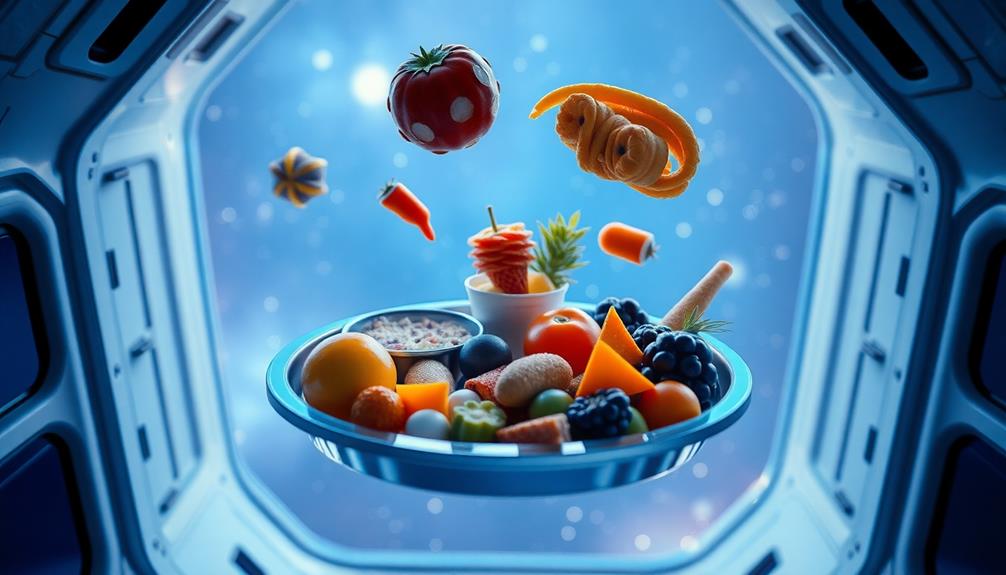
Although you might expect meals to taste the same in space, the reality is quite different due to microgravity's impact on your taste perception. In a space environment, fluid shifts can affect your nasal passages, leading to altered taste perception. This results in decreased olfactory function, causing many astronauts to find their meals bland and prompting a need for stronger flavors.
Research shows that certain tastes, like sweet and salty, may actually be amplified in microgravity. You might notice a preference for robust flavors, which is why spices and seasonings play an essential role in enhancing food acceptability. Notably, trigeminal sensations, such as astringency and pungency, are perceived more intensely, further influencing what you enjoy eating.
Here's a quick overview of how microgravity affects taste:
| Taste Sensation | Effect in Microgravity |
|---|---|
| Sweet | Amplified |
| Salty | Amplified |
| Astringent/Pungent | More intense |
As food scientists work on innovative preparation techniques, the goal is to guarantee you maintain a satisfactory diet, even when the universe feels a little bland.
Importance of Flavor Enhancement

Flavor enhancement plays an essential role in making space meals enjoyable and satisfying for astronauts. In the microgravity environment, taste perception changes, so astronauts report a need for stronger flavors.
To elevate their dining experience, consider these key elements of flavor enhancement in space food:
- Bold Spices: Incorporating spices like chili powder or garlic can create a more pronounced taste, essential for combating menu fatigue. For example, the use of bold spices is a hallmark of Mexican cuisine, making dishes like chilaquiles and quesadillas flavorful and exciting.
- Aromatic Additions: Enhancing food aromas, such as adding vanilla or almond scents, considerably improves flavor perception and overall satisfaction.
- Robust Seasonings: Salt and sugar might taste different in space; therefore, stronger seasonings help amplify these flavors, making meals more palatable.
- Trigeminal Sensations: Utilizing ingredients that provide warmth or pungency can enhance the eating experience, as astronauts perceive these sensations more intensely in microgravity.
Research Initiatives by NASA
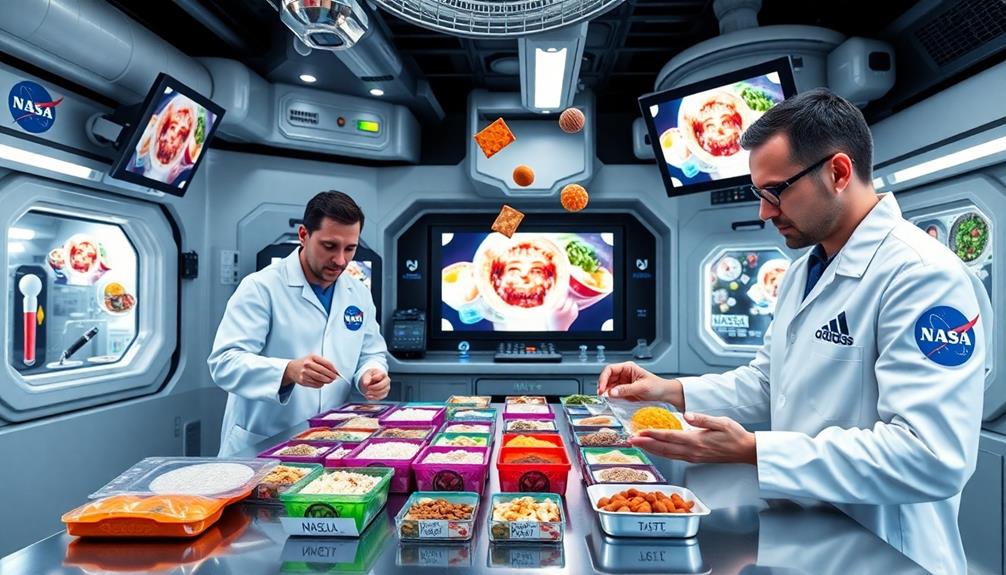
To guarantee astronauts enjoy their meals and maintain their health during missions, NASA has launched several research initiatives focused on food preferences in space. One of the key projects is the Advanced Food Technology initiative, led by Dr. Grace Douglas. This initiative collects real-time data and weekly surveys from at least 13 astronauts aboard the International Space Station (ISS).
By evaluating factors like appearance, flavor, texture, and aroma, NASA aims to understand what food preferences astronauts have during long-duration missions. In addition, incorporating familiar and comforting foods, such as traditional Italian dishes, could play a significant role in enhancing astronauts' meal satisfaction.
The ongoing research addresses the issue of menu fatigue, which can adversely affect astronauts' nutritional intake and overall well-being. To further enhance meal experiences, NASA's Deep Space Food Challenge encourages innovative solutions for space food systems, ensuring astronauts have access to safe, nutritious, and appealing meals on missions to the Moon and Mars.
Collaborations with researchers and organizations worldwide are essential in developing advanced food technologies that improve flavor and aroma perception in microgravity.
Innovations in Space Food Technology

How can we guarantee astronauts enjoy their meals during long missions? The answer lies in groundbreaking innovations in space food technology. NASA's Deep Space Food Challenge is steering efforts to combat menu fatigue and enhance space nutrition, making certain astronauts can savor their meals over extended periods.
Here are some exciting developments:
- 3D Printing: Imagine customizing your meals with a 3D printer that tailors food options to your preferences, making each dining experience unique. creative Halloween recipes can inspire similar ingenuity in space food preparation.
- AI and Digital Twins: These technologies simulate food processes, helping improve flavor and aroma, crucial for delicious meals in microgravity.
- Advanced Packaging: New packaging methods are being designed to extend shelf life while retaining nutritional quality, essential for missions lasting 3-5 years.
- Robust Flavors: Research is focusing on incorporating strong spices and flavors, catering to astronauts' altered taste perceptions and making every bite enjoyable.
These innovations not only enhance the quality of the food but also make certain that astronauts can maintain a varied and appetizing diet, overcoming challenges posed by menu fatigue during their journeys into the cosmos.
Psychological Effects of Food Choices

Food choices in space aren't just about nutrition; they play an essential role in astronauts' psychological well-being. In microgravity, your taste perception changes, making you crave stronger flavors. This means meals need robust spices and seasonings to enhance satisfaction, reminiscent of dishes like Sai Oua (Northern Thai Sausage) that offer bold flavors.
When you face menu fatigue, the repeated meal options can dampen your appetite and lead to inadequate nutritional intake, putting your health at risk during long missions.
The psychological effects of food choices extend beyond just taste; they greatly impact crew morale and cohesion. Positive dining experiences foster a sense of normalcy and community, essential for thriving in isolated environments.
The MARS500 experiment highlighted how important variety is in maintaining mental health. Without diverse options, astronauts can feel demoralized, which can further exacerbate menu fatigue.
Changes in aroma perception due to fluid shifts can also affect your food intake and satisfaction. This indicates that personalized food solutions are essential for meeting your nutritional needs and enhancing your overall experience in space.
Keeping the menu interesting and satisfying not only fuels your body but also supports your psychological resilience, crucial for mission success.
Long-Term Implications for Missions
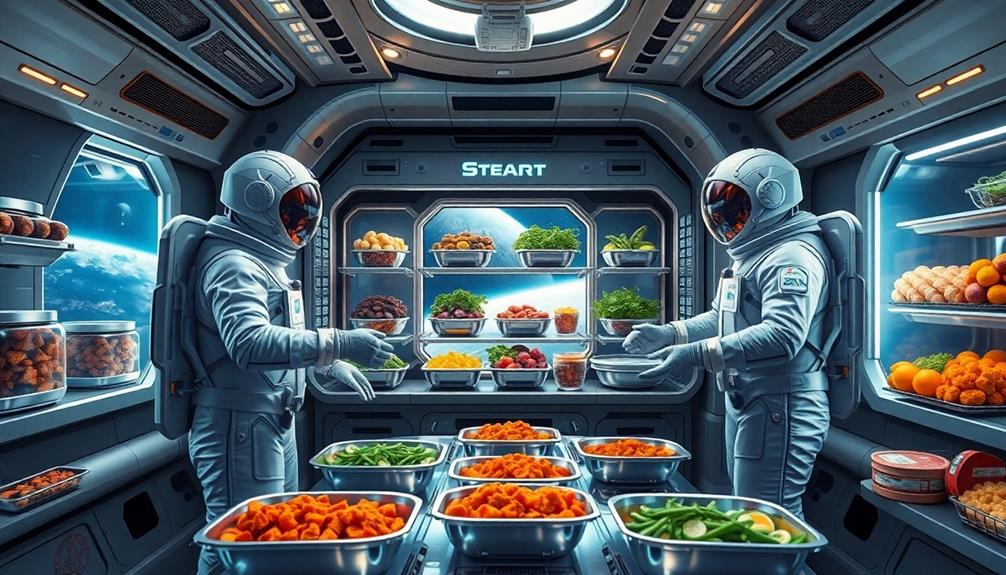
Menu fatigue poses serious long-term implications for astronauts on extended missions, impacting both their nutritional health and psychological well-being.
As you journey into future space explorations, the challenges of menu fatigue grow more pronounced. Over time, the limited selection of around 200 meal options can lead to decreased food appeal and even loss of appetite. This situation risks malnutrition, which is critical when meeting your dietary needs.
Consider the following potential outcomes of menu fatigue:
- Decreased Nutritional Intake: Limited food appeal could lead to insufficient nutrient consumption.
- Psychological Strain: Repetitive meals can foster feelings of monotony, impacting morale.
- Increased Preference for Bold Flavors: Altered taste perceptions in microgravity may shift cravings toward spicier, more seasoned foods.
- Innovative Solutions Needed: Strategies like 3D food printing and personalized aroma enhancements could help combat these challenges.
Future Directions in Space Nutrition
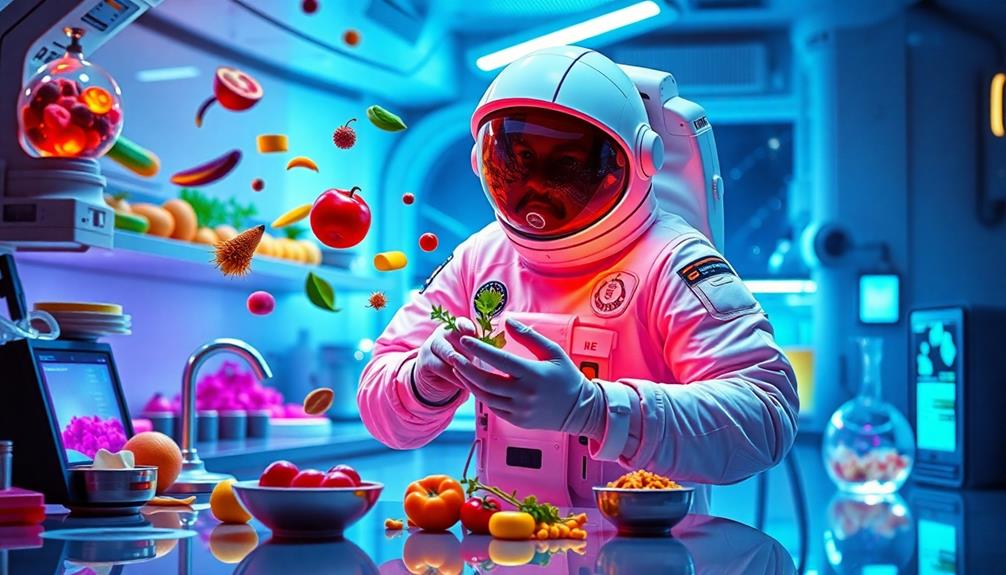
As we look to the future of space exploration, advancements in nutrition will play an essential role in ensuring astronauts remain healthy and satisfied during their missions.
One promising direction is the use of 3D printing technologies to create customizable meals tailored to individual preferences, effectively reducing menu fatigue. Imagine enjoying a meal that not only fits your taste but also meets your nutritional needs.
Research will also focus on enhancing flavor profiles. Astronauts in microgravity often crave stronger tastes, so incorporating bold spices can greatly improve meal satisfaction. This is critical for maintaining psychological well-being during long-duration missions.
Moreover, ongoing studies aim to improve food packaging to extend shelf life without sacrificing nutritional quality. This innovation is fundamental for future missions to Mars and beyond, where food must remain fresh for extended periods.
Frequently Asked Questions
How Has the Food That Astronauts Eat Changed?
Astronauts' food options have greatly expanded. You'll find fresher ingredients, diverse flavors, and innovative meal technologies. Enhanced seasonings cater to altered tastes, while customizable meals aim to improve your dining experience in space.
How Is Eating Different in Space?
Eating in space is different because you experience altered taste and smell, making stronger flavors more appealing. You also face menu fatigue, so diverse meals are essential to maintain satisfaction and nutrition during long missions.
Why Does Food Taste Different in Space?
You'd think food tastes the same everywhere, but in space, your taste buds play tricks. Microgravity dulls flavors, making you crave spices and stronger tastes, transforming bland meals into a quest for culinary excitement.
How Are Foods Stored, Prepared, and Served During Space Travel?
In space, you'll find foods vacuum-sealed or freeze-dried for longevity. You'll rehydrate meals with hot water and use special utensils to eat, enjoying a rotating menu to keep your taste buds engaged.
Conclusion
In the vast emptiness of space, your taste buds can feel lost, craving the familiar comforts of home while grappling with the challenges of microgravity. As astronauts adapt to menu fatigue and sensory shifts, the quest for flavor becomes a lifeline. Balancing nutrition with innovation, the future of space food isn't just about sustenance; it's about creating joy in isolation. Embracing these changes guarantees that even among the stars, your meals can still spark delight and connection.
Cooking
The Science Behind ‘Supertasters’ and Their Genetic Makeup
Get ready to uncover the fascinating genetic traits of supertasters and discover how they experience taste differently—what secrets lie in their unique palates?
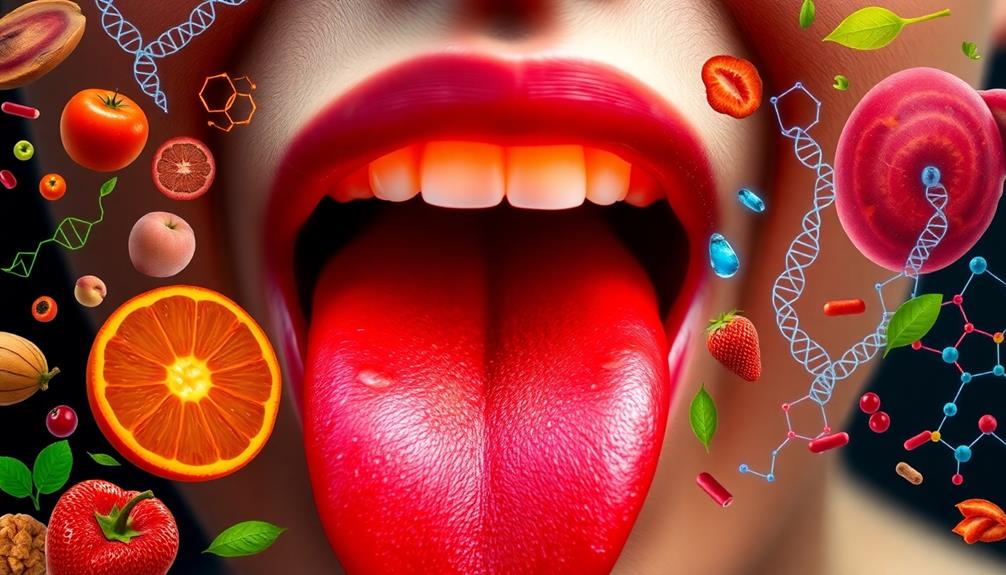
Supertasters are special because about 25% of people have a unique genetic makeup that affects their taste perception. You see, they have more taste buds—up to 60 in a tiny section of their tongue. This heightened sensitivity makes them particularly attuned to flavors, especially bitterness, linked to the TAS2R38 gene. If you're a supertaster, you likely avoid bitter vegetables like broccoli and prefer sweeter foods instead. While this can influence your diet, it also helps you enjoy vibrant flavors. Curious about how these traits affect eating habits and culinary experiences? There's plenty more to explore!
Key Takeaways
- Supertasters have heightened taste sensitivity due to increased taste bud density, resulting in intense flavor experiences.
- The TAS2R38 gene, particularly the PAV allele, is linked to strong sensitivity to bitterness in supertasters.
- Approximately 25% of the population qualifies as supertasters, with significant variations in taste perception globally.
- Supertasters typically prefer sweeter and milder foods, avoiding bitter options like broccoli and coffee, which impacts their dietary choices.
- Their unique taste sensitivity can lead to nutritional implications, as they may limit dietary variety due to aversions to certain flavors.
Understanding Supertasters
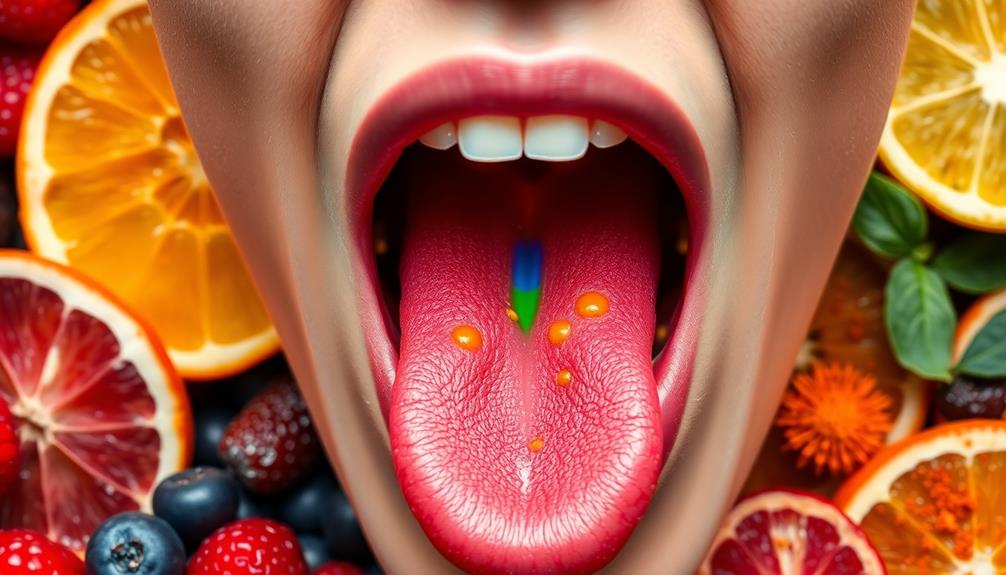
Understanding supertasters can transform how you think about taste. If you're among the 25% of people classified as supertasters, you have a heightened sensitivity to flavors due to a greater density of taste buds, especially the fungiform papillae. This means your experience of taste is markedly more intense than that of average tasters.
You might find yourself particularly sensitive to bitterness, which is largely linked to the TAS2R38 gene. This gene amplifies your perception of bitter compounds found in foods like broccoli and coffee, often leading you to avoid these flavors altogether.
Curiously, supertasters might also experience strong reactions to spiced dishes, such as Mushroom Masala, which are rich in complex flavor profiles. With anywhere from 35 to 60 taste buds in a six-millimeter section of your tongue, compared to just 15 to 30 for average tasters, your palate is finely tuned.
This heightened sensitivity can create selective food preferences, pushing you away from certain foods that might be enjoyed by others. If you're curious about your taste perception, genetic testing can reveal your status as a supertaster.
Understanding this unique aspect of your taste experience can enhance your culinary adventures and help you navigate flavors more effectively.
Genetic Basis of Taste Perception
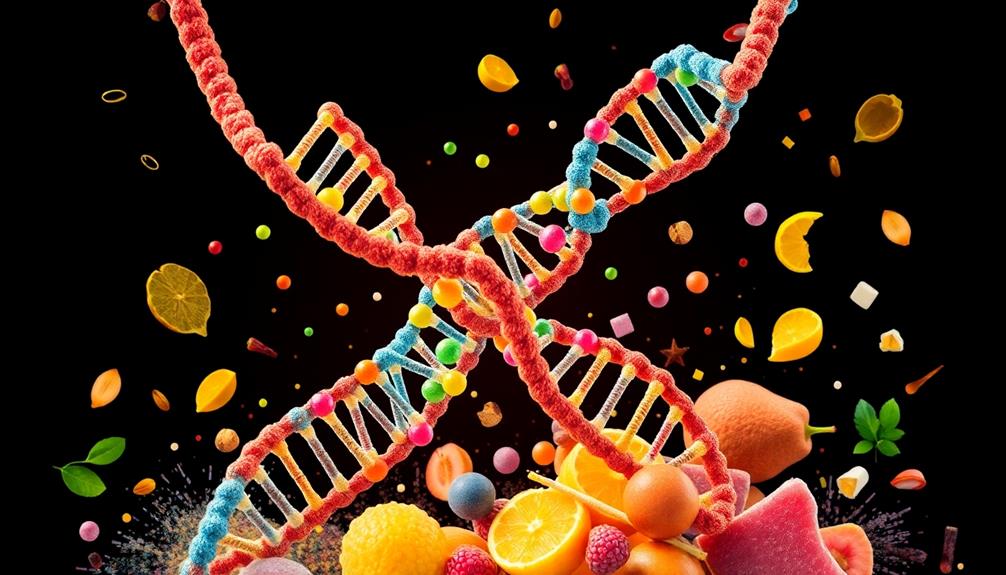
How does your genetic makeup influence your taste perception? Your sensitivity to flavors, especially bitter ones, is largely determined by genetic variation in the TAS2R38 gene. This gene plays an essential role in how you perceive bitter taste.
If you have specific alleles, like the PAV allele, you may experience heightened bitterness, affecting your food preferences and dietary choices. For example, those with heightened sensitivity might avoid certain dishes, such as Red-Braised Pork Belly, known for its rich flavors.
About 25% of people are classified as supertasters, a status linked to this genetic variation. Supertasters have more taste buds than average, amplifying their sensitivity to flavors. This heightened bitter taste perception often leads them to avoid certain foods, such as Brussels sprouts or coffee, that others might enjoy.
Genetic testing can help you discover whether you're a supertaster by analyzing the expression of these taste receptor genes. Notably, the distribution of tasters and non-tasters varies across different populations, underscoring how genetic factors shape taste experiences globally.
Characteristics of Supertasters
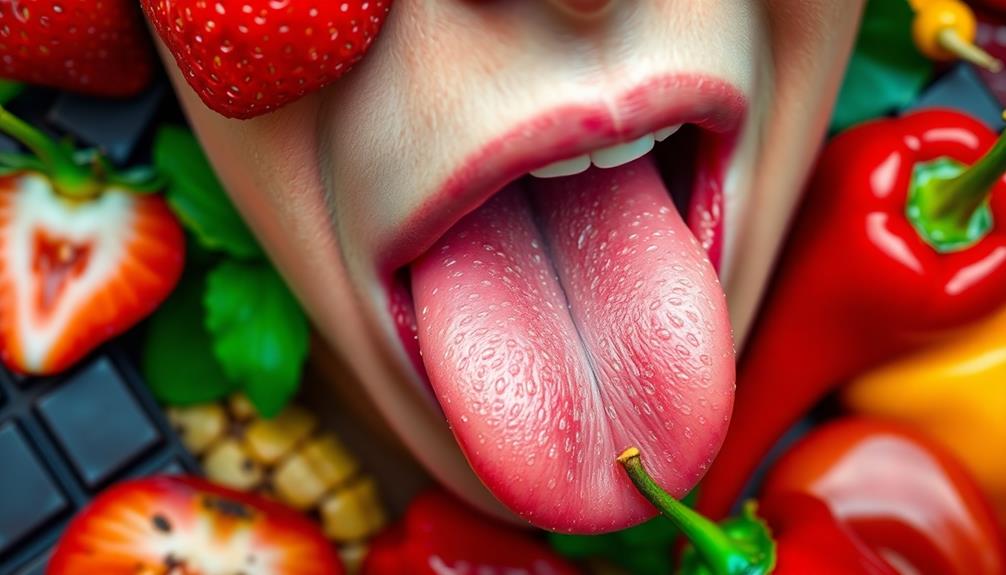
Supertasters are a unique group, making up about 25% of the population, distinguished by their heightened taste sensitivity due to a greater density of taste buds. If you're a supertaster, you likely have a variant of the TAS2R38 gene, which heightens your perception of bitterness in foods.
This heightened sensitivity often leads to strong aversions to bitter vegetables like broccoli and spinach, which can be overwhelming for your palate. Notably, this sensitivity can also affect your preferences for certain cuisines, as dishes like Hiyashi Chuka offer invigorating flavors that may appeal more to your palate than others.
You probably prefer sweeter or milder foods, steering clear of overly bitter flavors. Because of your acute sensitivity, you might avoid certain alcoholic beverages that have pronounced bitter notes, such as IPAs or dry wines. This distinctive way of tasting influences your food choices, leading to selective eating patterns that can impact your nutritional intake.
Being a supertaster can make dining out or trying new foods a bit more challenging, as you may find yourself less inclined to enjoy dishes that others rave about.
Understanding your unique taste preferences can help you make more informed dietary choices, ensuring that your meals are as enjoyable and satisfying as possible.
The Role of Taste Buds
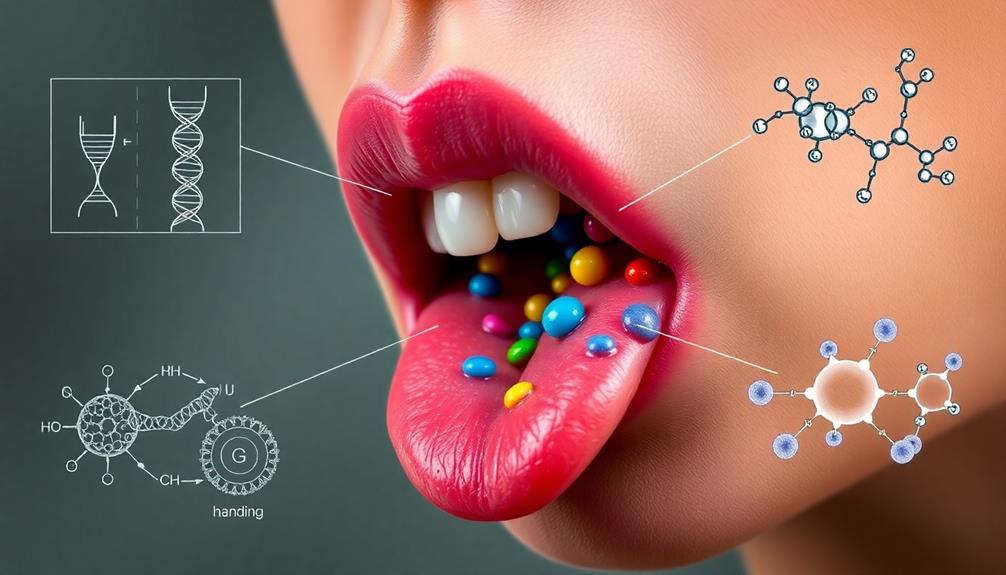
Taste perception starts with the intricate network of taste buds on your tongue, which play an essential role in how you experience flavors. Your tongue is covered in taste papillae, housing three types: fungiform, circumvallate, and foliate. These papillae contain taste buds, each made up of about 50 to 150 taste receptor cells, vital for detecting different tastes.
Notably, the diverse flavors found in Brazilian cuisine can be particularly impactful for super-tasters, as their heightened sensitivity to flavors allows them to fully appreciate the unique ingredients and spices used in traditional dishes.
If you're a super-taster, you likely have a higher density of taste buds—around 35 to 60 per six-millimeter section of your tongue. This abundance heightens your sensitivity to flavors compared to average tasters and non-tasters. The TAS2R38 gene plays a significant role here, particularly influencing your perception of bitter flavors, which can make certain foods more intense for you.
The physiological structure of your taste buds includes Type I support cells, Type II receptor cells for sweet, bitter, and umami sensations, and Type III presynaptic cells, each contributing to your overall taste experience.
This complex interplay of taste buds and receptor cells is what sets super-tasters apart, allowing you to savor flavors in a unique way.
Impact on Food Preferences
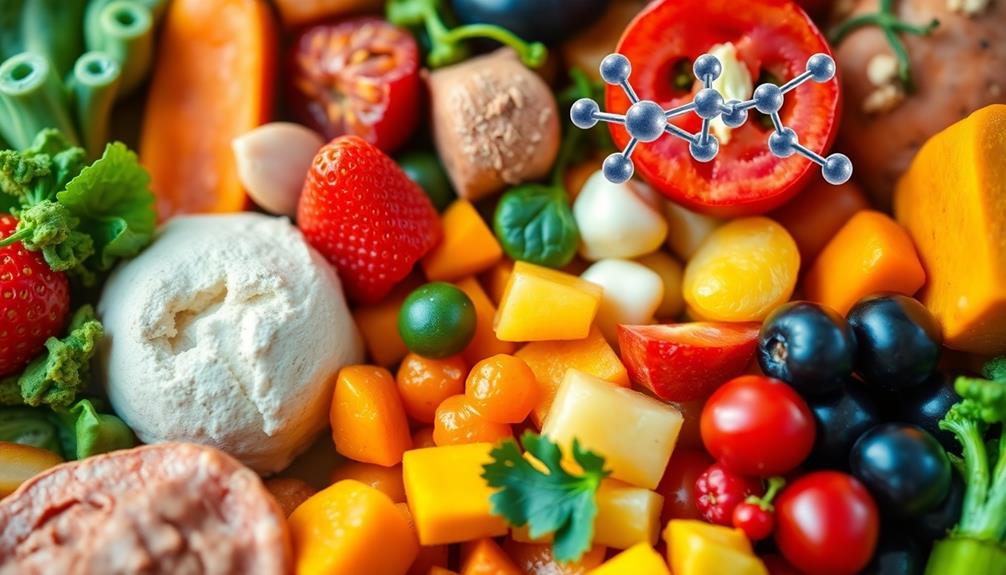
With a heightened sensitivity to flavors, supertasters often find their food preferences shaped markedly by their unique genetic makeup. You might notice that your palate leans toward sweeter or milder options, steering clear of bitter foods like broccoli or coffee. This aversion stems from the TAS2R38 gene, which influences your perception of bitterness. As a supertaster, you may even prefer high-salt foods, as they can offset bitterness and enhance flavors in dishes you might otherwise avoid.
Here's a breakdown of how your food preferences might differ:
| Food Category | Preference Level |
|---|---|
| Bitter Foods | Low |
| Sweet Foods | High |
| Salty Foods | Moderate to High |
| Processed Foods | Low |
| Healthier Options | High |
Your selective eating habits could lead to a lower risk of certain diseases, as you may consume fewer unhealthy foods. Embracing your supertaster traits can help you craft a diet that's not only enjoyable but potentially beneficial for your health.
Sensitivity to Bitterness
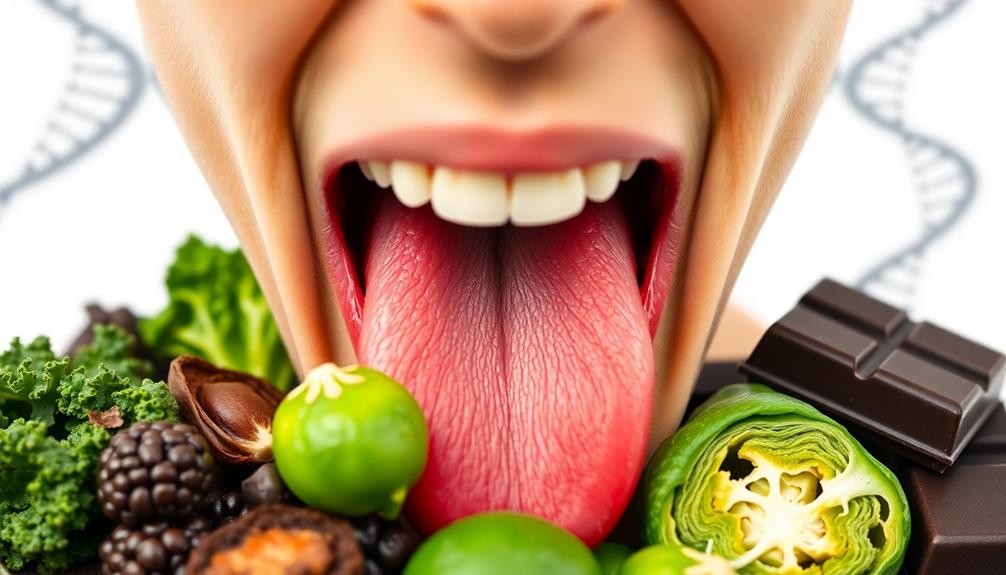
Your unique genetic makeup not only shapes your food preferences but also influences how you perceive bitterness. If you're a supertaster, you likely have heightened sensitivity to bitterness, which means you experience these flavors more intensely than average tasters. This sensitivity is often linked to the TAS2R38 gene, particularly the PAV allele, which makes you more responsive to bitter compounds like phenylthiocarbamide (PTC).
Notably, this heightened sensitivity can also affect your enjoyment of certain foods, including traditional dishes such as Ethiopian salad, which are often fresh and vibrant, potentially appealing to supertasters.
Approximately 25% of the population are classified as supertasters, and this distinct palate often leads to strong aversions to foods that are bitter, like broccoli and coffee. Research shows that supertasters can differentiate between varying levels of bitterness more accurately than non-tasters.
This ability affects your food choices and dietary habits, as you might find yourself avoiding certain bitter foods that others consume without issue.
In essence, your sensitivity to bitterness not only shapes what you enjoy eating but also influences your overall culinary experiences. Understanding this aspect of your taste perception can help you navigate your food preferences more mindfully, allowing for a better appreciation of flavors you do enjoy.
Nutritional Implications
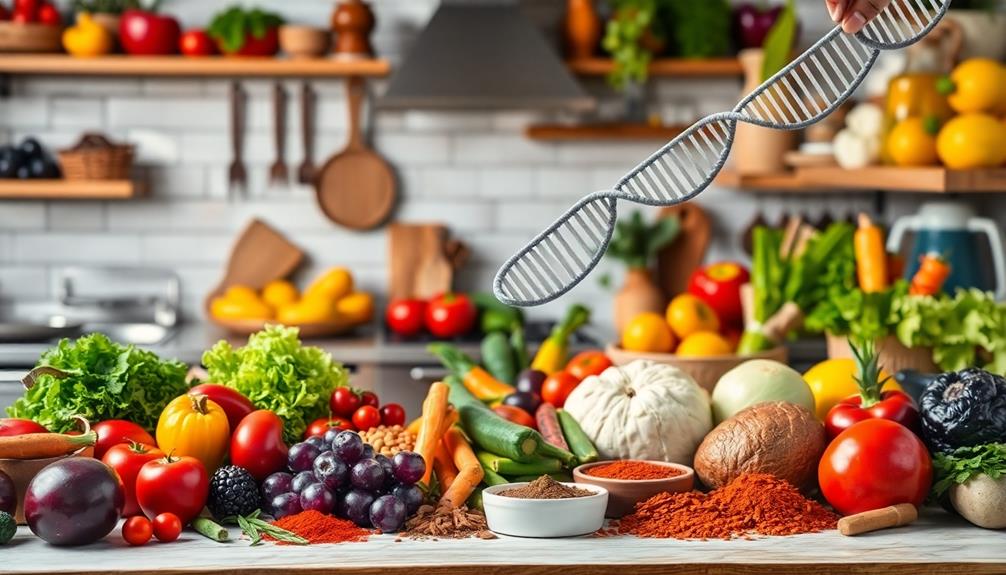
For supertasters, traversing the world of nutrition can be a complex journey shaped by their heightened sensitivity to bitter flavors. Your enhanced taste receptors can make certain nutrient-rich foods, like broccoli and spinach, seem unpalatable. This aversion might lead you to gravitate towards dishes that are more appealing to your palate, such as Southern comfort food, which often features milder and sweeter flavors that can sometimes mask bitterness.
As a result, you might find yourself avoiding these vegetables, which could lead to nutrient deficiencies over time. Additionally, your aversion to bitterness may cause you to prefer sweeter or milder foods, impacting your dietary variety. While this might seem enjoyable initially, it can restrict your nutritional intake, potentially influencing your overall health.
You may also notice that your calorie consumption tends to be lower, as you shy away from strong-tasting foods. This could aid in weight management, but it may not always be beneficial. Your acute sensitivity to bitterness might even extend to alcoholic beverages, limiting your social experiences and further narrowing your dietary choices.
Balancing your preferences with a varied diet becomes essential to guarantee you're meeting your nutritional needs. Embracing a broader range of flavors, including those you find less appealing, can help you maintain a healthier, more balanced diet.
Community and Research Engagement

Exploring the complexities of taste perception and nutrition can open doors to a vibrant community of individuals enthusiastic to share their experiences and insights.
Engaging in discussions about spooky snack ideas during Halloween can also enhance your understanding of how flavors may be perceived differently by supertasters. When you immerse yourself in genetic research, particularly the Bitter Taste trait report from 23andMe, you gain valuable information about your supertaster status and how it impacts your palate.
Engaging with this DNA community enables you to connect with others who share similar interests in taste genetics. Community features, such as discussion forums and newsletters, create an environment where you can exchange knowledge and learn from others' experiences.
These platforms encourage dialogue about how genetics influences taste perception, shaping dietary choices and preferences. Staying informed about the latest findings in genetic research is essential, especially as new studies emerge that enhance our understanding of supertasters.
Frequently Asked Questions
What Is the Evolutionary Reason for Supertasters?
You've evolved as a supertaster to better detect bitter flavors in food. This heightened sensitivity helps you avoid potentially toxic substances, enhancing your survival by guiding you toward safer, more nutritious choices in your environment.
Why Are Some People Called Supertasters and What Makes Them Different From the Average Person?
About 25% of folks are supertasters, meaning you might have more taste buds than average. This sensitivity makes you experience flavors more intensely, often leading to pickier eating habits and stronger aversions to certain foods.
What Might Be the Genetic Advantage or Disadvantage of Being a Super Taster?
Being a supertaster gives you a genetic advantage by enhancing taste sensitivity, helping you avoid harmful substances. However, it can also limit your diet, making social dining experiences uncomfortable and potentially leading to nutrient deficiencies.
Who Is More Likely to Be Supertasters?
Ever wondered who's more likely to be supertasters? Well, you might be surprised! Research shows that women often outnumber men in this category, but it's not just about gender—genetics play a vital role too.
Conclusion
In exploring the fascinating world of supertasters, you uncover the intricate dance of genetics and taste. Just like a fine wine reveals its layers, your palate might be more discerning than you think. Embracing your unique taste experience can lead to healthier choices and a deeper appreciation for food. So, whether you're savoring a gourmet meal or dodging bitter greens, remember, your taste buds are part of a grand symphony, playing their own beautiful notes in the culinary orchestra.
Cooking
How Lunar Cycles Influence Shellfish Flavor
Not only do lunar cycles impact shellfish flavor, but they also reveal fascinating connections between nature and taste—discover how this celestial dance unfolds!

Lunar cycles play a huge role in determining shellfish flavor, especially oysters. You'll notice that during new moons, oysters tend to open their shells more, adjusting their feeding patterns to optimize food intake. This feeding is essential since phytoplankton, a key food source, peaks at this time. Additionally, lunar phases influence spawning patterns, ensuring larvae are released when conditions are most favorable. The timing of these natural behaviors links directly to the rich flavors you enjoy in shellfish. Want to explore how these celestial shifts shape the flavors you taste? Keep going for deeper insights!
Key Takeaways
- Lunar cycles affect oyster behavior, leading to increased shell opening and feeding during new moons, which enhances flavor profiles.
- Nutrient availability peaks around new moons, providing abundant phytoplankton that contributes to better oyster taste.
- Tidal changes, influenced by lunar cycles, bring nutrient-rich waters essential for shellfish growth and flavor enhancement.
- Oysters synchronize spawning with lunar phases, ensuring optimal conditions for larvae, which supports population health and flavor.
- Artificial lighting disrupts natural lunar behaviors, potentially impacting the flavor profiles of shellfish.
Lunar Cycles and Shellfish Behavior

Lunar cycles greatly influence shellfish behavior, particularly in oysters. You'll notice how these captivating creatures open their shells more during new moons and close them tightly during full moons. This pattern isn't just about protection; it directly affects their feeding behavior. Oysters rely on lunar cues to maximize food availability, allowing them to filter feed effectively when conditions are best.
Curiously, similar to the way the flavors of Red-Braised Pork Belly develop with careful timing, the oysters' feeding aligns with the lunar phases for maximum efficiency.
What's even more fascinating is how oysters synchronize their spawning with lunar phases. They release their gametes during specific lunar cycles, enhancing their reproductive success. This timing guarantees that their offspring have the best chance of survival, coinciding with ideal environmental conditions.
The internal lunar clock of oysters operates independently of light intensity, showing their remarkable ability to track lunar cycles. This behavior isn't exclusive to oysters; various marine species, like corals and certain crabs, also align their reproductive activities with the moon, highlighting a broader ecological impact.
Impact of Moonlight on Oysters

You might be surprised to learn that moonlight greatly influences oyster behavior, especially their feeding patterns.
During different lunar phases, oysters open their shells more or less, adjusting to optimize food intake. This fascinating relationship with their environment mirrors how traditional dishes like Muamba De Galinha are celebrated for their rich flavors and cultural importance.
This synchronization with the moon can enhance their flavor, making it essential for you to reflect on lunar cycles when enjoying these delicacies.
Lunar Cycle Effects
Oysters display captivating behaviors in response to lunar cycles, particularly in how their shells open and close. During the lunar cycle, you'll notice that oysters are most open near new moons and least open during full moons. This shell opening pattern directly impacts their feeding patterns and, consequently, their flavor profiles.
Curiously, many traditional Brazilian dishes, such as Caldeirada, highlight the importance of seafood, showcasing the rich flavors that can be achieved through careful sourcing and preparation. Research shows that Pacific oysters (Crassostrea gigas) use an internal lunar clock to time their feeding with ideal plankton availability, which fluctuates with lunar phases. When their shells are wide open, they filter feed more effectively, allowing them to intake more nutrients. This increased nutrient absorption enhances their flavor, making them more desirable during specific lunar phases.
Curiously, even though moonlight is less intense than sunlight, it still plays a significant role in their behavior. The ecological sensitivity of oysters to these lunar cycles raises concerns about the effects of artificial lighting on their natural habits and the potential impact on their flavor profiles.
Feeding Behavior Changes
The rhythmic changes in shell opening behavior are closely tied to the influence of moonlight, which greatly affects oyster feeding patterns. Oysters, particularly during new moons, open their shells wider and more frequently to enhance feeding on plankton.
Research shows that these bivalves respond to lower moonlight conditions by increasing their feeding activity, capitalizing on food availability in the water column. Curiously, just as certain Indonesian dishes like Kue Putu are best enjoyed warm, oysters may also exhibit improved flavor profiles during ideal feeding times.
A study monitoring Pacific oysters (Crassostrea gigas) over three lunar cycles revealed that they opened their shells every 1.6 seconds, indicating a clear lunar rhythm in their feeding behavior. This synchronization with lunar cycles suggests that oysters may strategically time their feeding to match the movement of plankton, enhancing their chances of nutrient intake.
Understanding how moon phases influence oyster behavior not only sheds light on their feeding habits but also hints at seasonal variations in oyster flavor. When you consider the relationship between lunar patterns and nutrient availability, it becomes evident that the oysters you enjoy may taste better during specific lunar conditions.
This connection between moonlight and feeding behavior is essential for appreciating the complex factors that contribute to the unique flavor profiles of oysters.
Nutrient Availability and Flavor

Nutrient availability plays an essential role in shaping the flavor of shellfish, particularly oysters, which thrive in environments rich in microscopic algae and plankton. The lunar cycles profoundly influence this nutrient availability, especially during new moons when phytoplankton populations may peak.
As you observe oysters in their natural habitat, you'll notice that their spawning timing is closely linked to these lunar phases, ensuring that larvae hatch when nutrient conditions are best. This synchronization enhances the growth and flavor profile of adult oysters.
The quality of shellfish, like oysters, can also be influenced by seasonal dishes such as Nettle and Potato Soup, which highlight the importance of fresh, local ingredients. During specific lunar phases, the abundance of phytoplankton—oysters' primary food source—can fluctuate, impacting their growth rate and flavor.
Research shows that oysters cultivated in nutrient-rich conditions, often associated with certain lunar cycles, develop more robust flavor profiles, making them more marketable. By understanding the interplay between lunar cycles and nutrient availability, you can appreciate how these factors contribute to the unique taste of oysters.
Tidal Changes and Shellfish Growth

Tidal changes play a significant role in the growth of shellfish, particularly in how they interact with their environment. The regular tidal movements bring nutrient-rich ocean water into their habitats, providing a constant food source. As you observe the tides, you'll notice how they support the shellfish's feeding habits, allowing them to filter feed on microscopic algae and plankton. The turbulence from these currents also oxygenates the waters, promoting metabolic processes that enhance both health and flavor.
Moreover, tides influence shellfish spawning, as they help disperse larvae into suitable marine environments. This movement is vital for recruitment and population dynamics, which directly impact growth and overall flavor. Salinity levels, regulated by the mixing of freshwater and saltwater during tidal changes, further affect shellfish development. They thrive in specific salinity conditions, which can enhance their flavor profiles.
| Tidal Effect | Impact on Shellfish Growth |
|---|---|
| Nutrient Inflow | Essential for feeding and flavor |
| Oxygenation | Supports metabolic health |
| Spawning Timing | Aids larvae dispersal |
| Salinity Regulation | Influences growth and flavor |
Reproductive Patterns in Shellfish

Synchronizing their reproductive patterns with lunar cycles, many shellfish have developed unique strategies to maximize their spawning success. Oysters, for instance, release their eggs and sperm mainly during specific lunar phases, particularly around new moons. This timing enhances their chances of successful fertilization and larval dispersal.
During these lunar events, you'll notice oysters exhibit increased shell opening and feeding activity, aligning with ideal nutrient availability. The rich flavors of shellfish, much like those found in Mushroom Masala, can also be attributed to their health and liveliness during these reproductive periods.
Research shows that oyster spawning occurs mainly in warmer months, influenced by not just lunar cycles, but also environmental cues like temperature and photoperiod. Similarly, palolo worms engage in synchronized broadcast spawning on specific days in October and during the last quarter moon, emphasizing the crucial role of lunar rhythms in their reproductive strategies.
These adaptations guarantee that the reproductive behaviors of shellfish like oysters and palolo worms lead to effective fertilization, allowing their populations to thrive. By understanding these intricate patterns, you can appreciate how lunar cycles not only affect shellfish reproduction but also contribute to their flavor profiles, as timing influences the overall health and liveliness of these marine organisms.
Broader Marine Ecosystem Effects

When you consider lunar cycles, it's clear they affect not just shellfish, but the entire marine ecosystem. The cues from the moon can synchronize mating behaviors and influence nutrient cycling, which are essential for shellfish growth.
Additionally, the abundance of food sources like Loaded Baked Potato may be tied to these cycles, as they impact the distribution of phytoplankton and other marine organisms.
Plus, tidal movements play a significant role in creating the right conditions for these organisms to thrive.
Lunar Cues and Mating
Lunar cycles play a fundamental role in shaping the mating behaviors of various marine species, influencing everything from spawning times to population dynamics. Many marine organisms, including oysters, rely on lunar cues to synchronize their reproductive activities.
For instance, oysters open their shells considerably more during new moons, facilitating mass spawning events. This behavior is essential, as they're broadcast spawners, releasing millions of eggs and sperm. The timing of these releases directly affects successful fertilization and larval development. Notably, just as lunar cycles influence marine life, they can also affect terrestrial food sources, including Ethiopian dishes that rely on seasonal harvests.
Palolo worms are another excellent example; they spawn in synchrony with specific lunar phases, particularly during the last quarter moon in October. Corals and certain crab species also use moonlight cues to time their reproductive events, showcasing the widespread influence of lunar cycles across marine ecosystems.
The ecological importance of these lunar-driven mating behaviors is profound. By aligning their spawning with lunar cycles, species guarantee higher reproductive success, which impacts population dynamics and overall ecosystem health.
Understanding these connections helps you appreciate the intricate relationships within marine environments and highlights the significance of preserving these delicate ecosystems.
Nutrient Cycling Dynamics
Nutrient cycling is vital for maintaining the health of marine ecosystems, particularly in areas like Chesapeake Bay, where tidal movements bring in nutrient-rich waters. These tidal movements enhance conditions for shellfish growth, especially oysters, which play an important role in nutrient cycling. By filtering microscopic algae and plankton from the water, oysters link their feeding habits directly to the availability of nutrients in their habitat.
| Aspect | Impact on Oysters | Broader Ecosystem Effects |
|---|---|---|
| Nutrient Inflow | Supports feeding and growth | Enhances productivity of marine life |
| Reproductive Success | Increases population sustainability | Maintains balance within the ecosystem |
| Water Quality | Filters pollutants, improving clarity | Fosters a healthy habitat for diverse species |
The constant exchange of nutrients driven by tidal cycles helps balance the ecosystem, allowing oysters to thrive and reproduce effectively. Healthy nutrient dynamics guarantee the sustainability of oyster populations, ultimately contributing to their flavor profile and ecological role. By understanding these dynamics, you can appreciate just how interconnected marine life truly is.
Tidal Influence on Growth
Tides play an important role in the growth of oysters and other shellfish in marine ecosystems like Chesapeake Bay. As tides ebb and flow, they facilitate the inflow of nutrient-rich ocean water, which is essential for the survival and growth of oysters. This constant supply of nutrients allows oysters to filter feed on microscopic algae and plankton, enhancing their growth rates and influencing their flavor profiles.
Just as traditional Korean dishes rely on fresh ingredients, the health of these shellfish is directly linked to their marine environment.
Tidal movements also create turbulence in the water, ensuring adequate oxygen levels that are critical for oyster respiration and metabolic processes. This oxygenation supports their overall growth and health. Additionally, tides help maintain sediment dynamics by balancing sedimentation and removal, which is important for the health of oyster beds.
Furthermore, the timing of tidal currents greatly impacts the reproduction of oysters. It aids in the dispersal of larvae, promoting recruitment and affecting population dynamics. This reproductive cycle, influenced by tidal patterns, ultimately shapes the flavors of shellfish you enjoy.
Essentially, tidal influence is a key driver of growth, ensuring that oysters thrive in their environments, paving the way for rich and flavorful shellfish.
Future Research Directions

Investigating the relationship between lunar cycles and shellfish flavor offers exciting prospects for future research.
The delicate balance of flavors in shellfish can be comparable to the nuanced tastes found in traditional Japanese cuisine, such as the umami richness of Ankimo (Monkfish Liver Pâté).
You can explore deeper into how lunar phases influence various aspects of shellfish health and taste. Here are some key areas worth exploring:
- Feeding Behavior: Examine how different lunar phases affect the feeding rates of shellfish, particularly oysters, and how this impacts flavor accumulation.
- Phytoplankton Growth: Research ideal lunar conditions that promote phytoplankton growth, as this directly influences shellfish taste and nutritional quality.
- Spawning Timing: Analyze the relationship between the timing of spawning and lunar phases, evaluating how this affects shellfish health and their biochemical composition.
- Artificial Light Effects: Consider how artificial light influences lunar behavior and the subsequent flavor qualities of shellfish harvested in coastal regions.
Frequently Asked Questions
How Does the Moon Affect Oysters?
The moon affects oysters by regulating their shell movements, influencing feeding patterns. As the lunar phases shift, you'll notice changes in their availability of plankton, which can ultimately impact the oysters' flavor and quality.
Does Moon Cycle Affect Fish?
Under a shimmering full moon, you'll notice fish dancing in the water, their feeding frenzy heightened. Yes, moon cycles affect fish, altering their behavior, diet, and ultimately, enhancing the flavors you savor on your plate.
What Animals Are Affected by the Lunar Cycle?
You'll find many animals affected by lunar cycles, including crabs, salmon, and squid. Their mating and feeding behaviors often align with moon phases, showcasing the deep connection between lunar activity and marine life dynamics.
What Does the Lunar Cycle Affect?
Lunar cycles' light and pull profoundly affect various aspects of nature. You'll notice changes in tides, animal behaviors, and plant growth. These celestial rhythms create a fascinating connection between the moon and Earth's vibrant ecosystems.
Conclusion
As you savor a fresh oyster, think of it as a cosmic dance partner, twirling gracefully with the moon's rhythms. Just like the tides pull at the shore, lunar cycles tug at shellfish, influencing their flavor and growth. When you indulge in those briny delights, you're tasting the magic of the ocean's choreography. Understanding this connection not only enhances your culinary experience but also deepens your appreciation for the intricate web of life in our seas.
Cooking
The Unexpected Link Between Dental Health and Food Enjoyment
When dental health falters, food enjoyment diminishes—discover how to protect your smile while savoring every delicious bite.
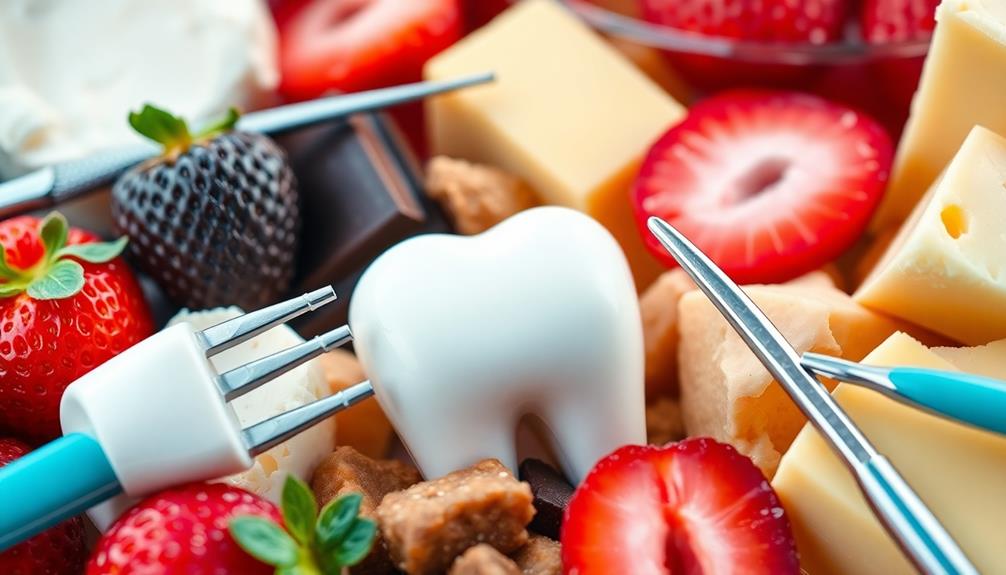
Your dental health is the secret ingredient to truly enjoying your meals. Healthy teeth and gums make chewing easier, allowing you to savor every bite. When you have dental issues, you might shy away from crunchy or sweet foods, limiting your choices and satisfaction. Plus, too much sugar can harm your teeth, reducing long-term enjoyment of treats. Warm beverages may also cause sensitivity, affecting your experience. By maintaining good oral health, you can explore a wider variety of nutritious options and truly enjoy your meals. Want to discover tips on how to protect your smile while enjoying food?
Key Takeaways
- Healthy teeth and gums enable effective chewing, enhancing the overall enjoyment of meals and food variety.
- Dental issues can limit food choices, causing pain that restricts the consumption of crunchy or nutritious foods.
- Excess sugar intake not only harms oral health but also diminishes the long-term satisfaction of enjoying food.
- Sensitivity to temperature and acidity can hinder the enjoyment of hot or cold meals, affecting social dining experiences.
- Prioritizing oral hygiene after eating can preserve dental health, ensuring continued enjoyment of a diverse diet.
The Role of Oral Health in Eating

When it comes to enjoying your meals, oral health plays a significant role. Your teeth and gums are essential for proper chewing, which directly affects your eating experience. If you're suffering from gum disease or tooth decay, you may find it painful to eat certain foods. This discomfort can lead you to avoid crunchy fruits and vegetables, which are key components of a balanced diet.
Traditional Ethiopian dishes, such as Yetimatim Fitfit, often rely on fresh ingredients that require good oral health for proper enjoyment. As a result, you might miss out on important nutrients that support overall health.
Maintaining healthy teeth and gums isn't just about preventing dental issues; it's also about enhancing your enjoyment of food. Studies show that individuals with good oral health report higher satisfaction with their meals. When your oral hygiene is on point, you can savor each bite without the fear of discomfort or pain.
Additionally, healthy teeth and gums support proper mastication, which is essential for effective nutrient absorption. By prioritizing your dental health, you'll not only prevent complications but also elevate your eating experience, allowing you to explore a wider variety of foods without hesitation.
Taking care of your oral health is a key step toward enjoying your meals to the fullest.
How Dental Issues Affect Food Choices
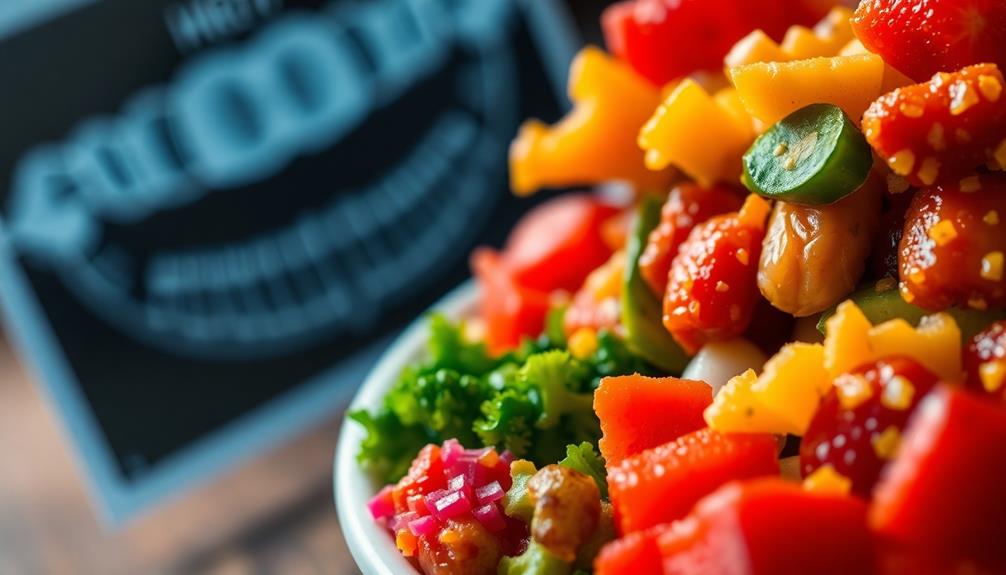
Dental issues can greatly impact your food choices and overall eating experience. When you face dental problems like cavities or gum disease, pain and discomfort often force you to avoid certain foods, especially those that are hard, crunchy, or overly sweet.
This avoidance limits your access to nutritious foods like fruits and vegetables, which are crucial for maintaining a healthy dietary balance. For instance, enjoying flavorful dishes like Mushroom Masala may become difficult if biting into even soft foods causes pain.
If you have tooth sensitivity, enjoying hot or cold meals becomes a challenge, affecting not just your meal satisfaction but also your social interactions. The fear of exacerbating dental pain can lead you to rely more on soft, processed foods that are typically higher in sugar and lower in important nutrients, further damaging your oral health.
As a result, poor oral health can greatly decrease your quality of life and dietary satisfaction. It's important to prioritize oral health care to promote your overall well-being.
The Impact of Sugar on Enjoyment

Sugar can have a significant impact on your enjoyment of food, particularly during festive seasons when indulgence is common. While sweet treats bring joy, excessive sugar consumption can lead to cavities and enamel erosion, ultimately diminishing your long-term enjoyment.
Traditional Brazilian desserts, like Brigadeiro, showcase the delightful use of sugar, but moderation is essential to prevent dental issues. Bacteria in your mouth thrive on sugar, producing harmful acids that contribute to dental problems. This can make eating and drinking less pleasurable.
Hidden sugars lurking in many festive foods only add to your overall sugar intake, increasing the risk of dental issues. Moderation is key; enjoying holiday sweets while balancing them with sugar-free alternatives helps maintain dental health and enhances your overall enjoyment of festive flavors.
Good oral hygiene practices after indulging are essential. Brushing your teeth and rinsing your mouth can prevent sugar-related damage, allowing you to savor your favorite foods without worry.
Warm Beverages and Sensitivity Issues

As the weather cools down, warm beverages like coffee, tea, and cider become favorites for many. However, you should be aware that these drinks can pose risks to your dental health. Their acidity can lead to tooth sensitivity and discomfort, especially if you're already prone to these issues.
Frequent consumption of acidic drinks contributes to enamel erosion, increasing the risk of cavities. Enjoying flavorful foods such as Red-Braised Pork Belly alongside these beverages can also heighten the risk of sensitivity due to the rich flavors and textures involved.
To enjoy your warm beverages without compromising your mouth hygiene, consider a few strategies. First, sip water between drinks. This simple habit helps neutralize acidity and reduces the potential for enamel wear.
Second, using straws can notably minimize contact between the drink and your teeth, which protects your enamel and reduces sensitivity.
If you already experience tooth sensitivity, be extra cautious with the temperature and acidity of your beverages. It's important to find a balance that allows you to savor your favorite warm drinks without exacerbating discomfort.
Navigating Holiday Treats Safely

The festive season brings a tempting array of holiday treats that can be hard to resist, but traversing them safely is key to protecting your dental health. Many holiday goodies are packed with sugar, which can lead to cavities and enamel erosion. Enjoying these treats in moderation is essential for maintaining good oral health.
For instance, consider using leftover turkey from Thanksgiving to create a satisfying turkey sandwich that can be enjoyed without the added sugars of many holiday desserts; Turkey Sandwich (For Leftovers) can be a delicious and healthier alternative. Be mindful of hidden sugars in festive foods; reading labels can help you choose healthier options.
When sipping on warm beverages like hot chocolate or spiced cider, remember they can cause tooth sensitivity. Alternating with water helps neutralize acidity and protect your teeth.
Crunchy treats, such as roasted nuts, can pose a risk of cracked teeth. To enjoy them safely, consider consuming them sliced or chopped.
After indulging in holiday treats, prioritizing dental care by brushing and flossing is vital for preserving your dental health.
Strategies for Enjoying Food Healthily

While holiday feasts can be delightful, finding ways to enjoy food healthily is vital for your overall well-being. You can savor your favorite foods without compromising your oral health. One great way to enhance your meals is by incorporating seasonal dishes like Nettle and Potato Soup, which not only provides nutritional benefits but also adds a unique flavor profile to your holiday table.
Here are some strategies to take into account:
- Prioritize moderation by limiting sugary treats, as excessive sugar can lead to cavities and enamel erosion.
- Choose sugar-free alternatives for holiday favorites to satisfy cravings without dental issues.
- Incorporate water breaks between acidic beverages like coffee or cider to neutralize acidity and protect your teeth.
- Opt for sliced or chopped crunchy snacks, such as nuts, to reduce the risk of cracked or chipped teeth.
Maintaining good oral care practices is essential. Brushing and flossing after meals effectively removes plaque and food particles, ensuring that your food enjoyment doesn't jeopardize your healthy smile.
Make regular dental visits a priority to further reduce the risk of dental problems. By following these tips, you can indulge in delicious foods and beverages while still keeping your oral health in check.
Frequently Asked Questions
What Is the Link Between Oral Health and Nutrition?
Your oral health directly affects your nutrition. Healthy teeth and gums enable you to chew and swallow effectively, while poor oral care can lead to pain, making it harder to enjoy a balanced diet.
How Does Food Affect Dental Health?
You might not realize it, but your favorite treats can harm your teeth. Sugary and acidic foods erode enamel, while crunchy snacks can crack teeth. Remember to rinse and practice good hygiene for healthier dental health.
What Is the Connection Between Dental Health and Overall Health?
Your dental health directly impacts your overall well-being. Poor oral hygiene can lead to systemic diseases, increase inflammation, and complicate conditions like diabetes, emphasizing the importance of maintaining good dental practices for better health.
What Are Three Risk Factors Associated With Dietary That Have Links to Poor Oral Health?
You should be wary of excessive sugar, as it leads to cavities. Also, acidic drinks can erode enamel, and frequent snacking creates acid attacks on your teeth. These factors considerably increase your risk of dental problems.
Conclusion
So, next time you're about to indulge in that gooey chocolate cake, remember: your dental health isn't just about avoiding the dentist's chair—it's also about savoring every bite without wincing. After all, who wants to choose between a bright smile and a slice of pie? Embrace the irony of loving food while battling plaque! With a little care, you can enjoy your treats and keep your teeth intact. Now, go ahead and crunch into that carrot stick—how thrilling!
-

 id4 months ago
id4 months agoPanduan Karir Internasional untuk Warga Indonesia
-

 id4 months ago
id4 months agoTemukan Keindahan Pendopo Jakarta sebagai Destinasi Anda
-

 id4 months ago
id4 months agoBerbagi Opini Anda – Wawasan untuk Indonesia
-
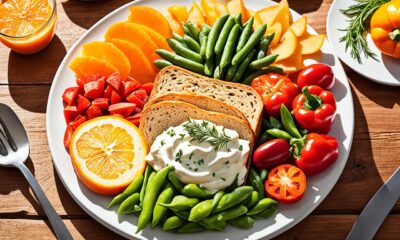
 id4 months ago
id4 months agoKesra Sebagai Pilihan Pangan Sehat untuk Keluarga
-

 id4 months ago
id4 months agoBerita-Terkini Indonesia: Info Terbaru Hari Ini
-

 id4 months ago
id4 months agoRahasia Sehat dengan Olahraga Rutin Anda
-

 News4 months ago
News4 months agoUnderstanding Ekonomi: Basics and Beyond
-

 News4 months ago
News4 months agoThe Heartbreaking Story of Tim Chapman's Wife



























